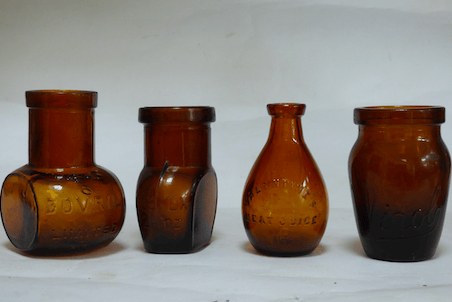Old bottles and pots dredged from the Basingstoke Canal during its restoration in the 1980s give a fascinating insight into the everyday products local people used years ago.
The volunteers who did such great work clearing the canal of silt and other debris, and restored the numerous locks on the stretch of the canal in the Woking area, must again be congratulated for their work nearly 40 years ago.
Among those volunteers were Ken and Denise Hall and their two daughters. They have now kindly donated to me a number of their finds.
The items featured in this week’s Peeps are fairly small, so the volunteers did well to spot them in the mud that was being dredged from the canal bed.
Of the brown glass bottles pictured, the one on the left is a Bovril bottle that dates to the early 1900s.
It was in Germany in the 1840s that Baron Justus von Leibig came up with a concentrated meat extract.
Bovril came later, originally produced in Canada by Scotsman John Johnson. He was a butcher and in 1870 was awarded a contract to supply beef to troops fighting the Franco-Prussian War.
There was plenty of beef in the Americas but getting it fresh to eastern France was a problem – so Johnson’s meat extract came about and he named it Johnson’s Fluid Beef.
Soon it was being sold in Britain too – but by a much catchier name, Bovril, meaning great strength from an ox.
It is said the word is derived from the Latin bovinus, meaning ox, and vrilaya, the word meaning a superior race, from Victorian novel The Coming Race.
In years gone by, Bovril was consumed in Britain in huge quantities and would have been a nourishing alternative for those who could not afford fresh meat. Today it is made by Unilever.
The next bottle along is embossed with the word “Beefex” and next to it is a bottle embossed “Valentine’s Meat Juice”. The latter product was sold for medicinal purposes.
It was a tonic invented in 1870 by Mann S Valentine II, of Richmond, Virginia, US, initially for his wife Anne Marie. She had become seriously ill with a condition that meant she could not digest solid food.
The tonic he came up with was a mixture of beef juice and egg whites – and it worked.
He produced more and sent samples to doctors – and the Valentine’s Meat Juice company was set up.
It was not long before the drink reached Britain, where it became very popular during the early 20th century.
The other brown glass bottle contained a product that many people still recall – Virol.
First produced in London at the end of the 19th century, it was initially an experimental product by Bovril and designed as a nutritional supplement to feed to infants.
If you had Virol when you were a child you may remember it being brown, sweet and sticky and given to you on a spoon.
You were probably told it was made with malt extract, which was correct. However, early versions contained bone marrow extracted from the bones of butchered cattle.
The bottle seen here dates to about the 1930s or 1940s.
Other items rescued from the canal were once available over the counter in your local chemist’s.
One is a pedestal, which looks like a lid from a pot or jar, from the early 1900s.
A smidgen of the product, Singleton’s Eye Ointment, was spread on top of the pedestal and then covered with a wax paper seal to preserve it.
There was a green bottle that contained Delightfully Perfumed Smelling Salts. It is amazing the label did not disintegrate as a result of the bottle being in the canal for so long.
The bottle is pretty, has a glass stopper and would have graced an Edwardian lady’s dressing table or been carried in a handbag.
A ceramic dish was also recovered. It has printed on it the same logo as pharmaceutical and health and beauty giant Boots still uses today.
However, the once-famous slogan “cash chemists” – meaning patent medicines sold for cash rather than on credit – is no longer used.
The dish would have had a ceramic lid, possibly with the name and details of the product printed on it, but more likely a circular paper label.
The dish appears to date from the 1920s onwards and probably contained a beauty product such as cold cream.





Comments
This article has no comments yet. Be the first to leave a comment.